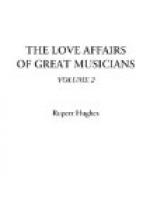The domestic and home-establishing influences of music might be pleaded even more strongly from the life of Mendelssohn. A more musical home than that in which Mendelssohn grew up, could hardly exist, nor one in which family life reached a higher level of comfort and delight. Like Mozart, Mendelssohn was especially devoted to his sister. Her death indeed grieved him so deeply, that he died shortly after. A man of the utmost cheer and wholesomeness, revelling in dancing, swimming, riding, sketching, and billiards; he was idolised in the circle around him, though his life was not without its enmities. He had many slight flirtations, but seems to have been even engaged but once, to Cecile Jeanrenaud, whom he married. His home life was a repetition of that ideal circle in his father’s house. A busier life or a more pleasantly respectable can hardly be found in the history of men, nor yet a more truly musical.
A life of similar brilliance and similar musical immersion was that of Liszt, whose domestic career was nevertheless as different as possible. A soul of greater generosity, and more zealous altruism in many respects, it would be hard to find, and yet his relations to women were, in the conventional view, a colossal and multifarious scandal. Have we any more right to blame his domestic outrages to the music that was in him, than to the almost equally intense religious ardour that fought for him, leading him again and again to seek to enter a monastery, and finally actually to take orders? Abelard was a sufficiently tempestuous and irregular lover, yet he was a priest, and not a musician. Can we then blame harmony and melody for the humming-bird “amours” of the Abbe Liszt,—for the many women he made material love to from his early youth,—for the very dubious honesty of his bearing toward the Comtesse d’Agoult and the Princess Wittgenstein, with whom he debated the formalities of marriage without hesitating over the actualities?
There is a strange cluster of domestic infelicities centring about Liszt. The Comtesse d’Agoult loved him so ardently that she braved the world for him, driving even her complacent husband to divorce her; but even then, though they lived together, Liszt did not marry her. He even brought George Sand, the ex-mistress of so many men, including Liszt himself, to live at the house with the comtesse, who had borne him three children out of wedlock. One of these children became the wife of Hans von Buelow, who was driven to divorce her that she might marry his teacher, Richard Wagner, whose first wife had endured twenty-five years of his irregularities in everything, except poverty, and who separated from him during the last five years of her life.




